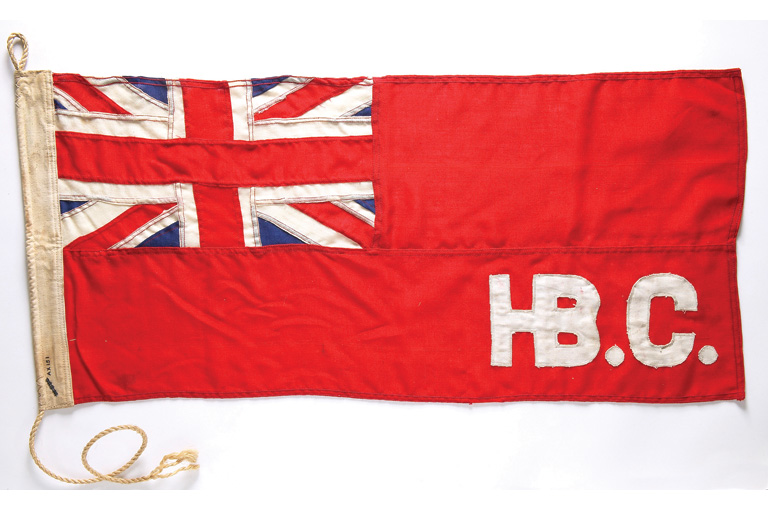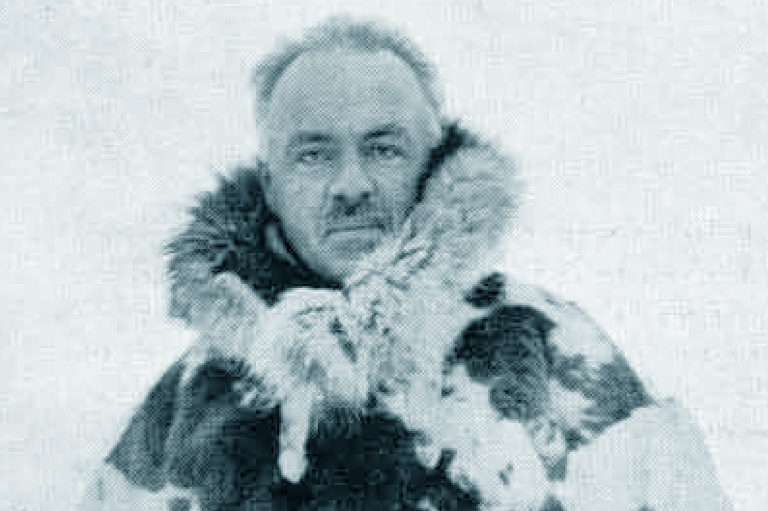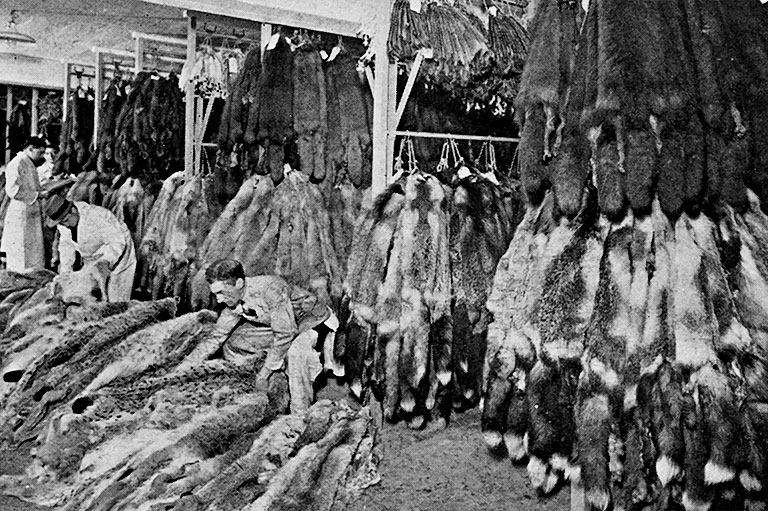Stuffed Beaver with All the Trimmings
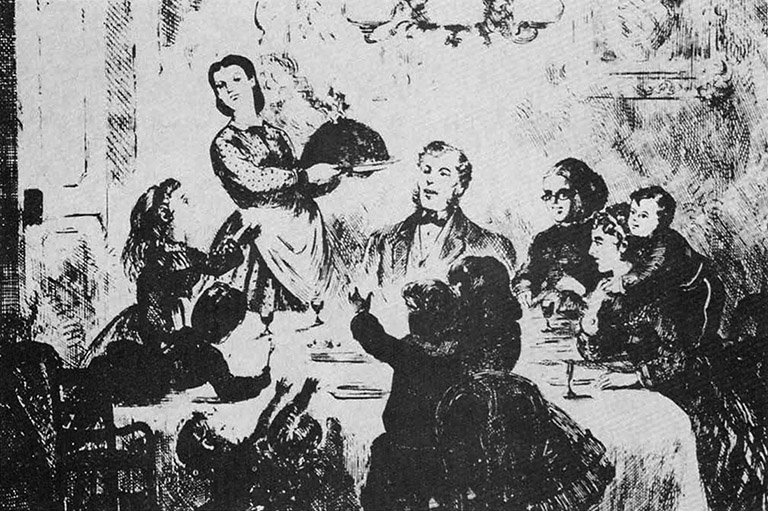
Christmas at Moose Factory in the year 1747 was a cold and miserable occasion. “Spent the Day in Religious Exercise”, wrote the far from jovial John Potts, “and to prevent hard Drinking I did read over to them one of the Little Books Your Honrs. was pleased to send us last year; wch. is a Disswasive from the Sin of Drunkenness. I gave them a Little Liqur. in the Evening and at Eight O Clock Ordered all hands to bed and the Lights out.”
It was a poor year for trenchermen and not much better for tipplers. The thoughts that passed through the minds of “all hands” as they settled into their cold beds can only be imagined. We can probably be certain, however, that feelings of loyalty to the Governor and Company were at a low ebb as Mr. Potts snuffed the candles.
The glow of Christmas shone a bit brighter at Manchester House on the North Saskatchewan in 1789 when the traders of the Hudson’s Bay Company sat down to a frugal but jolly meal. “This being Christmas Morning,” it was recorded, “our small stock of Flour, afforded us, a Cake to eat, with a little Tea & Chocolate, (which we all apparently enjoyed very much) no one can know what it is to want Bread, but those who experience it, (which we here, daily do, in this Wild Country; particular Holidays only excepted).”
The pickings were rather more sufficient on the shores of Lake Athabaska in 1820 when George Simpson joined in the celebrations and later wrote: “This being Xmas day the people had a dram in the morning and were allowed to make holyday. The Gentlemen sat down to the most sumptuous Dinner that Fort Wedderburn could afford, true English fare. Roast Beef and plum pudding and afterwards a temperate Kettle of Punch.”
The word “temperate” could mean anything, but we can hope that the rum flowed freely at that long ago Christmas. They lived hard lives and the few comforts that came their way were well earned.
Simpson, in fact, appears to have been a hearty and generous host when the occasion called for it. On two occasions in the 1830s a friend at Red River wrote to James Hargrave at York Factory in praise of Simpson’s hospitality. “The Governor has given two [or] three grand let outs”, gushed a letter of December 1830. A year later the correspondent returned to the same theme: “I wish we had you here during these festivals. I think we would line your Ribs, Good Fat Beef for 3 half pence a pound as sleke as Ten.”
Roast beef was not always available on the frontier. On the Stikine River on 25 December 1868 the traveller Charles Frederic Morrison found himself enjoying an unusual substitute for turkey, goose or beef. “Our Christmas dinner,” he recalled later, “consisted of a young beaver stuffed like a suckling pig, which proved delicious. Lynx also makes a good stew if you do not think of cats, and squirrels make un grand ragoût.”
The tail of the beaver was considered a delicacy in pioneer times and is still enjoyed by some discerning people in the wilderness. The preparation of beaver tail, for those of you who are someday confronted by a raw specimen while half a dozen hungry friends look on, is almost as simple as poaching eggs. First, remove the tail from the body. Blanch it in boiling water and peel off the outer skin, as you would peel a blanched tomato. Place the tail on a rack over a drip pan and bake in a moderate oven for half an hour or until done.
Beaver tail can also be skewered on a green stick and cooked over an open fire, but if you are like me, you will find that the stick always burns through. Then the meat falls into the fire. Scorched beaver tail is not the dish that made mouths water on the Stikine in 1868.
In 1883 Mrs. Clarke of Toronto published a cookery book that contained a tempting recipe for a Christmas soup that sent Canadian wives rushing to alert their cooks. Almond Soup, as promoted by Mrs. Clarke, is not often seen on Canadian tables at Christmas at this end of the century, but it may not be too late for a comeback. The soup, according to the Clarke method, is easy to make: “Throw some sweet almonds in boiling water to get rid of the husks and skins. Pound them in a mortar with some lukewarm water, adding by degrees pounded white sugar and pounded cinnamon. Turn it out on a plate or dish which must be able to stand the fire, previously lining the bottom with fingers of bread powdered with cinnamon. Thoroughly heat these ingredients over a clear fire and serve.”
Some readers, of course, will want to do all this in a blender or food processor. Go ahead, but it will not be authentic. Mrs. Clarke, like many early cookery book writers, was vague about proportions. With old recipes, you often play it “by ear”.
Mrs. Clarke, Canada’s Fanny Farmer, was more precise in her excellent recipe for bread sauce, an essential accompaniment to roast turkey. Her method is as follows:
Bread Sauce (For Poultry or Game)
Take all the giblets from a fowl, place in 1 pint of water and add 1 onion, 10 whole peppers and 1 blade of mace. (Use 1/2 tsp. powdered mace.) Simmer for 1 hour, then strain the liquor over 1/4 lb. bread crumbs. Place in a stewpan, cover and let it stand over a low heat without boiling for 1 hour. Beat with a fork until smooth. Boil for 5 minutes, stirring well until thick, add 2 tbsps. cream and serve hot.
—Mrs. Clarke’s Cookery Book, Toronto, 1883
In our own day, bread sauce graces the table when turkey is served. In the nineteenth century, in the more remote corners of the Dominion, it could easily have enhanced a dish of roast porcupine, haunch of bear, fox, or wolverine or possibly a stew made of muskrat or moose. Bread sauce may well have been on the table when one of the last curlews was served up at a Canadian Christmas dinner long ago.
Today we trim the fat away. Our great grandparents gorged on it. Out in the wilderness they would have died without it. A fatty bear ham was a prized dish at Christmas in a pioneer community and eyes sparkled when a stew of black squirrel came to the table.
Pies made of wild berries were popular in the summertime, but at Christmas the pioneer wife relied on preserved fruits for her pies and puddings.
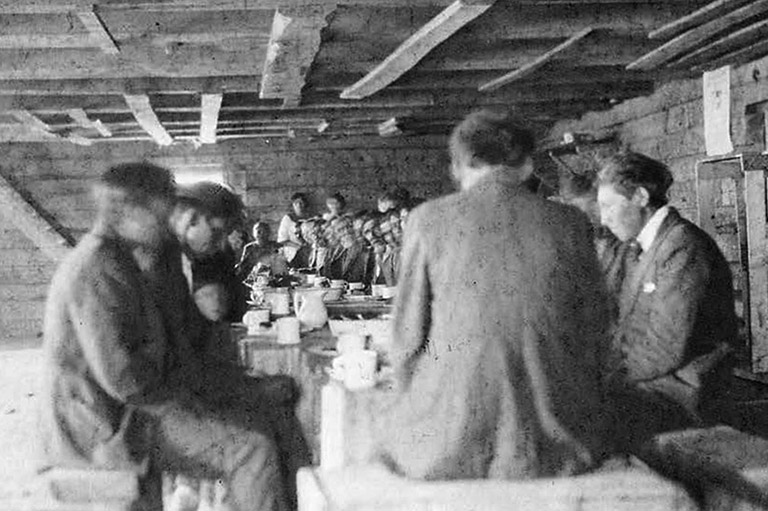
The early Canadian Christmas table groaned under its weight of food. It was an age that cared little for diets and slim bodies. A great belly indicated a great man.
Meals that would stop us cold in our tracks were joyfully consumed by our Victorian ancestors and their grandparents. They enjoyed a salad, but they were primarily meat eaters and, when they got the chance, they ate a lot. As the nineteenth century drew to a close and the twentieth century dawned, the grand fourteen-course banquet became a popular feature of Canadian social life. In The New Cook Book, edited by Grace E. Dennison in 1906, the proper form for one of these gargantuan meals was laid down as follows:
1. Shell fish—small clams or oysters, one half dozen for each person, laid in their shells on a bed of finely crushed ice. With these are offered red and black pepper, grated horseradish, small thin slices of buttered down bread or tiny crisp biscuits and quarters of lemon. 2. Soup. 3. A course of hors d’oeuvres, such as radishes, celery, olives and salted almonds. 4. Fish, with potatoes and cucumbers, the latter dressed with oil and vinegar. 5. Mushrooms or sweetbreads. 6. Asparagus or artichokes. 7. Spring lamb or roast with a green vegetable. 8. Roman punch. 9. Game with salad. 10. A second entree. 11. A rich pudding. 12. A frozen sweet. 13. Fresh and crystallized fruit and bonbons. 14. Coffee and liqueurs.
On Dominion Day 1898 in Dawson City a hungry crowd sat down to attack a banquet that consisted of Consommé à la Jardinière, Rockpoint Oysters, Gherkins, Piccalilli, Lobster Cutlets à la Newberg, Pickled English Walnuts, Chicken Salad en Mayonnaise, Broiled Moose Chops aux Champignons, Tongue, Roast Beef, Boiled Ham, Bengal Club Chutney, Saratoga Chips, Assorted Cakes and Jellies, Pears, Peaches, Edam Cheese and Coffee.
At Christmas feasts in the age of the pioneer the pudding was, as it is today, of supreme importance. The old traders in their forts wanted pudding too, but they often had to make do with something less than the perfect pudding. Margaret Arnett MacLeod describes the place of pudding in the old world of the fur trade:
“The story of the fur trade plum pudding is an epic that has not been written: how through a long period it kept alive the spirit of festivity at lonely posts in a lonely land; how it was achieved, always with difficulty, often in spite of almost insurmountable obstacles; and how it always triumphed, even when the spirit had almost faded, or had a hard fight to survive.
Currants and raisins specially ordered from England were hoarded from the spring shipment. Breadcrumbs might have to be omitted, or eggs, milk, spices and other ingredients considered essential. Pudding cloths of doubtful history were often pressed into service. There were even times when the number of raisins and currants per guest had to be reckoned, or dried saskatoon berries used instead. Amazing concoctions were stirred and wishes made, sometimes with wondering Indians as spectators of the traditional rites, but the ultimate result was always pronounced a masterpiece! At sight of the pudding borne in steaming on a platter, or enveloped in dancing blue flame, everybody’s spirits soared.”
An authentic Hudson’s Bay Company nineteenth century Christmas pudding is to be found in Anne Clarke’s The Hudson’s Bay Cook Book, published by the old firm in 1899. The tempting recipe, preserved and handed down for the use of readers of The Beaver, is as follows:
Christmas Pudding
Ingredients: Pick and stone 2 lbs. of good Valentias; pick, wash and dry 1 lb. of currants; chop 2 lbs. of beef suet; have ready 1/2 a lb. of brown sugar, 6 oz. candied peel, cut thin, 2 1/2 lbs. of flour, 6 eggs, a quart or more of milk, an ounce of mixed spice, and a tablespoon of salt.
Put the flour into a large pan, add the plums, currants, suet, sugar, peel, spice and salt, and mix them well together while dry. Beat the eggs well up in a large basin, and add a portion of the milk, stirring it at the same time. Make a well in the middle of the flour, and pour in the milk and eggs. Keep stirring till all the ingredients are thoroughly mixed. Add more milk if necessary, and stir up again; the batter should be rather stiff. Have a good stout cloth ready; wet and flour it well, lay it over a pan, pour in the batter, and tie it firmly up. When the water in the copper or large kettle boils, put the pudding in and let it boil gently for five or six hours. Turn it carefully out of the cloth. Serve with or without sauce.
Turkey was not always available in the old days, but our pioneer ancestors always found something to stand in for the noble bird. Passenger Pigeon, now extinct, but which once darkened the sky as it passed in great flocks, was a favourite, often preserved in brine. Another possibility was moose nose, still a popular dish with natives in the wilds. The preparation of this curious treat is simple in the extreme and no degree from the Cordon Bleu school is required. The nose must first be separated from the head and antlers. Then burn off the hairs. The naked nose is then diced and boiled with vegetables.
Those who have eaten moose nose claim that the meat improves if it is hung for a few days. Others prefer it smoked. Some will not touch it.
There is no point in telling people how to cook a turkey. Everyone wants it the way mother used to cook it and, whether it is served with forcemeat or chestnut sauce, it is bound to give satisfaction—unless the cook is a complete duffer.
An interesting change from the traditional turkey might be Roast Haunch of Venison, a popular item in the 1899 Hudsons Bay Cook Book:
Roast Haunch of Venison
Trim the joint neatly, wipe it well with a cloth, rub it over with butter, and sprinkle it with salt; then wrap it up in a sheet of buttered kitchen paper. Make a paste with flour and water, roll it out to the thickness of about half an inch, wrap the joint in this, and close up all the openings carefully by wetting the edges of the sheet of paste; lastly, pack up the haunch into a sheet of well buttered paper, put in the oven for about three hours, basting occasionally, then remove the paste and paper coverings, baste the haunch plentifully with butter, and when nearly done dredge some flour over it and some salt. Serve on a hot water dish.
Haunch of venison might be served with a currant sauce, described in The Canadian Housewife’s Manual of Cookery, published in Hamilton in the year 1861. The method of preparation is simple: Boil one ounce of dried currants in half a pint of water for five minutes. Add one half cup of bread crumbs, six cloves, one glass of port wine and one teaspoon of butter. Stir until smooth, remove from heat and pour over the venison.
Bon appetit.
Themes associated with this article
Advertisement

Canada’s History Archive, featuring The Beaver, is now available for your browsing and searching pleasure!

